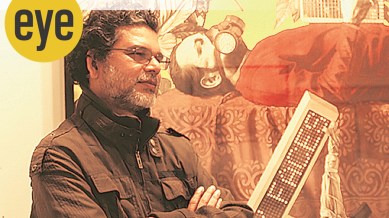Why artist TV Santhosh’s work is a search to understand history and the violence of our times
TV Santhosh’s works, on display in Ernakulam, Kerala, seek to question our understanding of our surroundings and ask who the real enemy is

Artist TV Santhosh believes that there are almost always a number of solutions to any conflict. “My focus is on trying to understand history and the reasons behind constant wars and conflicts. At any given moment, some war is happening somewhere. It is a continuous process, like an endless chain of action and reaction, often exposing the darker side of humanity… When you look at the larger picture, you realise that there is often an alternative, a probable solution to the unrest the world is dealing with,” says the Mumbai-based artist.
In the exhibition titled “History Lab and the Elegy of Visceral Incantations”, organised by the Kerala Lalit Kala Akademi at Durbar Hall Art Gallery in Ernakulam, he elaborates on this line of thought, carefully presenting the realities and deliberating on the diverse scenarios. If a painting portrays a televised war, depicting how the turbulent outside world enters our drawing room through television channels, in the sculptural installation When World Enters Your Home, a gun is affixed onto a door with insertions signifying bullet marks. “It is a reminder to the kind of violence that is happening and stories of attacks that we confront. The metaphorical door has guns placed on both sides. The rifle on the inside is meant to protect people from an attack outside, where an AK 47 is fixed… When you look at each episode of violence individually, then there is a clear picture of the enemy. But when you look at the same event from a large humanistic point of view, the distinction between the victim and the aggressor gets blurred. In the end, it is the human beings themselves who are being victimised,” says Santhosh.
monthly limit of free stories.
with an Express account.
The newsprint often influences texts in the cataclysmic narratives where images find manifold interpretations as Santhosh explores themes of terrorism, injustice, war and how perceptions are influenced by the media. “Our connection to the outside world is essentially through news media that exposes us to the turbulent realities and contemporary situations. The second-hand experience becomes part of our everyday experience, redefining the nature of our relationship with the outside world, bringing forth stories of violence, cries of innocent victims; but once again there is an inherent issue of who is the attacker and who is the victim — this can be approached through various angles, historical and ideological points of view and the answers will be different,” says Santhosh.
Trained in sculpture at Kala Bhavan, Santiniketan, the artist, who completed his MFA from Maharaja Sayajirao University in Baroda, notes that his works seek to question our understanding of our surroundings, contemplating, “Who is the real enemy?”. Santhosh says, “On the one hand, it is a political question but it is also a philosophical question.” If his first solo, “One hand clapping/siren”, presented by Guild Art Gallery in 2003 in Mumbai featured near-monochromatic paintings, in the 2008 installation, A Room to Pray, he created a space to pray, with walls that appeared as a pile of bones. The centre table was symbolic of Leonardo da Vinci’s The Last Supper. At the Grosvenor Gallery in London in 2014, he “appropriated” images that refer to the “notion of being under attack and being wounded”. “It’s like as soon as India begins to recover from one attack another one happens. It happens all over: we keep inflicting wounds on society. When it heals, another wound occurs,” he says, in the concept note.
Often modelled on himself, the central protagonists, who appear in his works, are usually his studio assistants. “There are autobiographical elements but they are the main characters of the story… It is almost like what would be there in a one-act play, where the same actor enacts different roles. Several objects and props are placed around to tell stories, from skulls to rat traps and knives,” says Santhosh. The practice, perhaps, also originates from his own theatre days as a student in Thrissur, when he also made political posters for street plays. “We often go back in time and restore something we did, discovering new meanings,” adds Santhosh.
His projection of the future though is rather bleak. The titular sculpture in the ongoing exhibition History lab IV incorporates an “apocalyptic clock”. “History has its multiple complex narratives. Many scientists, over time, have predicted that the world is not going to last forever; the end might come due to ecological reasons or man himself committing a huge crime against humanity… The clock is a metaphor for the inevitable doom and catastrophe,” says Santhosh.